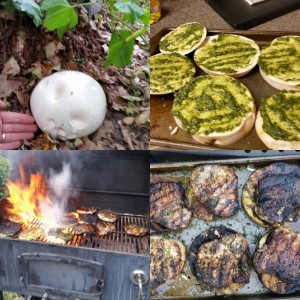Hello Fellow Readers, Last week I mentioned that my neighbor Bill ate his volleyball – a Giant Puffball Mushroom, that is, Calvatia gigantean. I have a volleyball, too, that I’ve been monitoring in amazement, but it didn’t occur to me to eat it!
I’ve always admired folks that know what they’re doing scavenging for wild mushrooms. I’ve read there are several thousand varieties, and while most are technically edible, lots are not pleasant to eat, and up to 250 varieties are considered significantly poisonous. That’s enough for me to stay clear of scavenging. But the Giant Puffball Mushroom is easy to find and hence one of the ‘foolproof four’ for beginner wild mushroom enthusiasts to feast on.
They’re found in the fall growing in open areas such as grassy fields, lawns, and near roads. Clearly, they’re hard to miss because of their size. There are a few poisonous look-a-likes, but they don’t grow as large as a volleyball. So harvesting a volleyball-sized one is a safe bet. They’re tasty when the flesh is firm and white on the inside and out. Use them within a day or two after harvest, as they don’t have a good shelf life. Once they turn yellow or greenish, they can cause an upset stomach. In maturity, the inside of the puffball turns into a huge bag of green spores – hence why the common name is Giant Puffball.
Some think mushrooms are a vegetable, but they’re a fungus packed with vitamins and minerals that boost energy levels and lower cholesterol. Many contain enzymes and anti-oxidants that help your immune system. Some mushrooms aid arthritis and inhibit diabetes and cancer. They’re low in calories; best of all, wild mushrooms are free!
The skin of the Giant Puffball is leathery but easy to peel off before cooking. To prepare, slice them into quarter or half-inch slabs. You can lightly salt, pepper, and sauté in oil or butter until golden brown. Or, coat with a milk and egg wash before dusting with seasoned flour, then fry. You can also dice the puffball and add it to soups, rice, or risotto dishes.
My neighbor Bill pureed his in basil, olive oil, garlic, salt, and pepper. He also said, ‘you could do the balsamic, rosemary, garlic, olive oil go-to marinade for mushrooms.’ Gee Bill, not only are you a fun guy; you’re a fungi connoisseur!
Garden Dilemmas? askmarystone@gmail.com
Column updated 10/2/22




